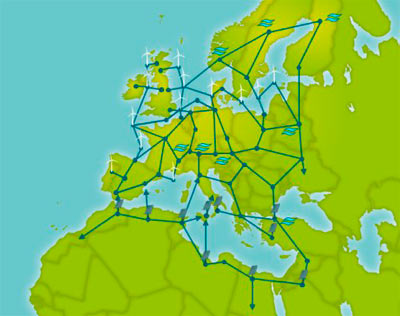 The Supergrid is a massive project to connect renewable power and decarbonize Europe over the next four decades. With its rallying cry of "No Transition without Transmission" the supergrid consortium intends to link up all the national grids in Europe to facilitate the large-scale use of renewable power. Some of the visionaries behind this, like Mainstream Renewable Power's Eddie O'Connor, visualize a Europe generating 100% renewable electricity, without any fossil fuels or nuclear reactors.
The Supergrid is a massive project to connect renewable power and decarbonize Europe over the next four decades. With its rallying cry of "No Transition without Transmission" the supergrid consortium intends to link up all the national grids in Europe to facilitate the large-scale use of renewable power. Some of the visionaries behind this, like Mainstream Renewable Power's Eddie O'Connor, visualize a Europe generating 100% renewable electricity, without any fossil fuels or nuclear reactors.
The Friends of the Supergrid, a support organization for the project, are having their second annual conference on Tuesday 19th March in Brussels. Details here: fosg-event.eu. The FOSG is a non-profit umbrella organization based in Brussels which was formed by a group of companies to assist in the promotion of the supergrid and its regulatory framework. They include Alstom, ABB, Dong Energy, Siemens, GE, the UK's National Grid and Mainstream Renewable Power among their member companies: a heavy-hitting brigade.
The plan is to have an overall structure technical, financial and administrative, to ensure that the national grids over Europe can connect up and share power across national boundaries. The vision is that Norwegian hydro-power could light up Italy when solar or wind is not active, and vice versa.

There are no technical impediments or "Show Stoppers" in the supergrid jargon. HVDC cable technology is well understood and all practical problems have been solved. However, this would be a massive task, and expensive, but in a world of instability, energy security is important, even without factoring in the environmental damage and increasing scarcity of fossil fuels. The EU intends to have a single European electricity market by 2014 and has a target of reducing greenhouse gases - by 20% by 2020 and by 80-95% by 2050, (against 1990 levels).
The problems for the supergrid lie more in the area of whether the participating countries will be inclined to fund such a costly project while they are having such severe financial problems. Eddie O'Connor gave evidence to the UK's parliament in 2011 that it would cost 200 billion Euros ($275 billion) in total, with a first stage of 28 billion Euros by 2020. Though this sounds like a colossal amount, spread over the decades and between perhaps 20 countries, it is not that a great investment for a major move forward in infrastructure. In addition it is expected to lower offshore wind costs by 25%, and create jobs. The first "nodes" of the Supergrid are likely to be in the North Sea or between the UK and Ireland, where connections either already exist or are planned. If the EU framework is in place then the network can grow organically as more connections are added. It would encompass all forms of renewable energy, but wind turbines would be a major component. The EU wind energy sector installed 11.6 gigawatts (GW) of capacity in 2012, bringing the total wind power capacity to 105.6 GW, according to the 2012 annual statistics from the European Wind Energy Association (EWEA), which was 2.2 GW more than was installed the previous year.

Unfortunately the harsh economic conditions are starting to bite and roll-out of new projects is stalling. Overall, the EU is almost 2 GW (1.7%) under its National Renewable Energy Action Plan forecasts. Eighteen Member States are falling behind, including Slovakia, Greece, Czech Republic, Hungary, France and Portugal. It remains to be seen how this will impact on the whole supergrid project.
The conference will bring together the latest developments and thinking on the project. Contributors include FOSG CEO Ana Aguado, futurologist Jeremy Rifkin, Eddie O'Connor and EU MEP Sir Graham Watson. This year they are instituting an award for the for the best Supergrid-related project of the year 2012. The upside of this pioneering project is that it will solve problems and lead the way for other groups of countries to institute similar, advanced, environmentally-beneficial energy grid systems.
SUPERGRID 2013 will take place on Tuesday, 19th March 2013 in Brussels.
For further information:
* * * * *
Julian Jackson has covered subjects at EarthTimes.org such as the Sail Transport Network and Jan Lundberg's autobiography Songs of Petroleum. His website is julianjackson.co.uk. His profile is at linkedin.com/profile/view?id=52846092
Further reading:
A fly in the ointment? The Price of Green Energy: Is Germany Killing the Environment to Save It?
FROM DER SPIEGEL by Markus Dettmer, Peter Müller and Cornelia Schmergal, March 12, 2013
"The German government is carrying out a rapid expansion of renewable energies like wind, solar and biogas, yet the process is taking a toll on nature conservation. The issue is causing a rift in the environmental movement, pitting "green energy" supporters against ecologists."

